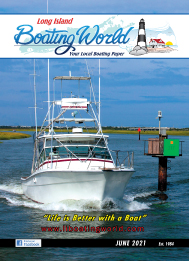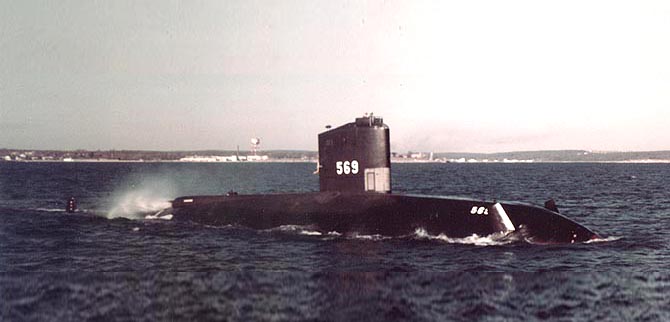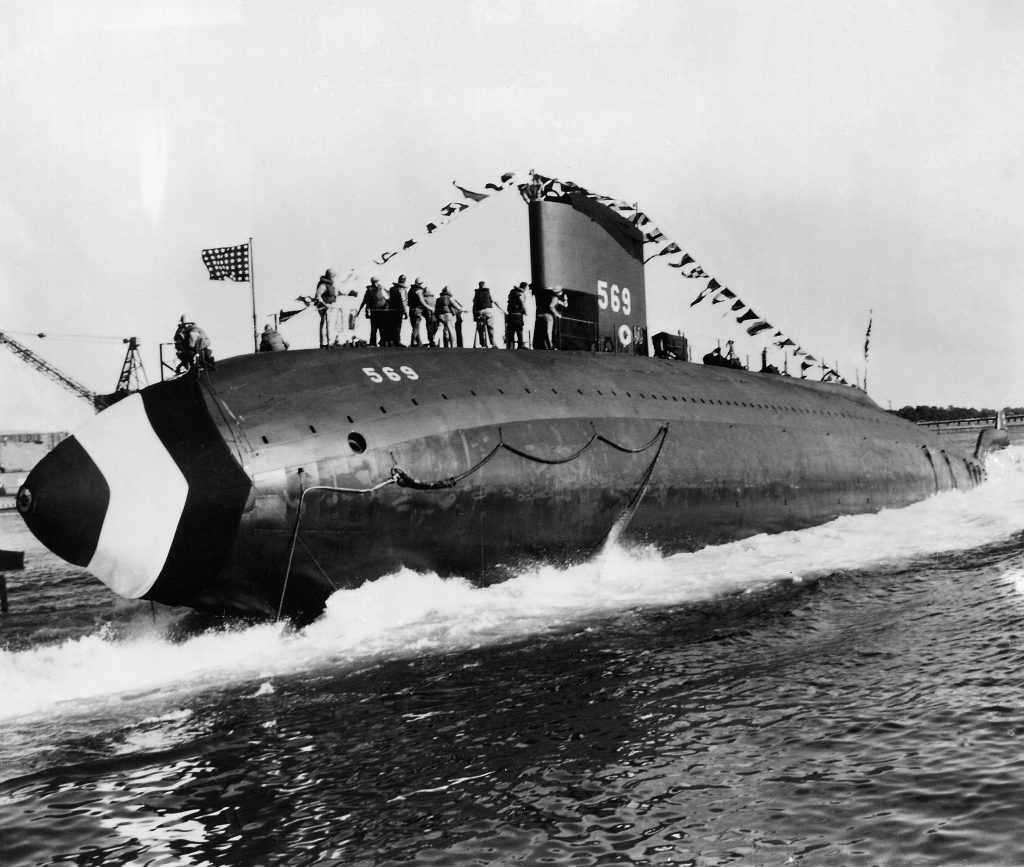
USS Albacore AGSS-569 was a unique experimental submarine that pioneered the teardrop hull design also referred to as the “Albacore hull” of modern submarines. The innovative design was based on the “Lyon Shape” named for Hilda Lyon, a streamlined design originally used for airships. She was a British born mathematician and an Associate Fellow of the Royal Aeronautical Society who devoted her career to aeronautical engineering. Her design was refined for Albacore utilizing extensive hydrodynamic and wind tunnel testing with an emphasis on underwater speed and maneuverability.

Albacore was the third ship of the United States Navy to be named for the albacore or Long Fin Tuna.
Her keel was laid down on 15 March 1952 by the Portsmouth Naval Shipyard of Kittery, Maine, she was launched on 1 August 1953 and commissioned on 6 December 1953 with Lieutenant Commander Kenneth C. Gummerson in command. Albacore’s launch sponsor was Mrs. J. E. Jowers, the widow of Chief Motor Machinist’s Mate Arthur L. Stanton who perished on the original Albacore SS-218, a Gato class submarine lost in 1944 and believed to have been sunk by a mine off northern Hokkaidō Japan on 7 November.
The history of battle success of submarines during World War II influenced both the Soviets and the United States Navy that undersea warfare would play an important role in future conflicts and that spurred development of superior performance capable submarines. As well the advent of nuclear power encouraged the expectation that such warships could be produced and the effort to achieve that goal required the development of marine nuclear propulsion systems and the design of a streamlined submarine hull capable of optimal submerged performance.
Since nuclear power plants would operate without the necessity for an oxygen supply as combustion engines do and techniques were already available to cleanse carbon dioxide from contaminated air and convert it back into breathable oxygen, submarine design engineers turned their attentions to vessels which could operate for extended time periods while remaining submerged. So, they visualized a revolutionary type of submarine in which surface performance characteristics would be generally subordinated in favor of submerged high speed and agility. Consequently, that led to a series of hydrodynamic studies then a program within the U.S. Bureau of Ships to determine the best suitable hull for submerged operation. And subsequently the U.S. Navy modeling facility at the David Taylor Model Basin located in Bethesda, Maryland tested a series of designs. Then the best two, one with a single propeller and the other with dual screws, were then tested in a wind tunnel at Langley Air Force Base in Virginia. Eventually, the single-screw version was adopted and construction of an experimental submarine was authorized on 25 November 1950. The pressure hull was manufactured from HY-80 high-strength steel with a yield strength of 80,000 psi (550 MPa). HY-80 remained the standard submarine pressure hull steel employed through the USN Los Angeles class submarines (688 & 688i) in service from 1972 to 1996, and all other primary metal components were made from high-tensile steel (HTS.) The new submarine was classified as an auxiliary submarine (AGSS-569) and named Albacore.

Following preliminary acceptance trials, the new submarine sailed from Portsmouth on 8 April 1954 to begin sea trials and embark on the first cycle of a career in which she experimented extensively with one new specified hull configuration and then returned to Portsmouth for extensive modifications to evaluate different design concepts in order to assist the Navy with development of improved hull forms for future submarines. On her first sea trial she operated out of New London, Connecticut before sailing for Key West, Florida to conduct operations out of that port and into Cuban waters. It was found during these early sea trials that Albacore could operate at the same maximum speed as the older but modernized Guppy-type submarines while expending only half the shaft horsepower.
Next the submarine sailed on 12 October 1955 via Block Island for Key West to commence antisubmarine warfare evaluation and to provide target services to the Operational Development Force’s Surface Antisubmarine Development Detachment. Then on 4 November 1955, Admiral Arleigh Burke, Chief of Naval Operations, embarked on Albacore for a brief inspection cruise after which the submarine navigated to a rendezvous point off the Bahamas where she conducted special operations.
From December 1955 to March 1956, Albacore underwent stern renewal modifications. Until this time, her propeller had been encircled by the rudder and stern plane control surface devices and with her “new look” she resembled a blimp having her propeller located aft of all control surfaces.
Operations with her new stern configuration started in April 1956 and continued until late in the year and in May Albacore visited New York City and participated in the television production Wide, Wide World, a popular TV program of the time during which she submerged with an underwater camera mounted on her forecastle, the first live telecast of a submarine during a dive.
In November 1956, Albacore reentered the shipyard for an engine conversion and afterward she performed operations out of San Juan, Puerto Rico, and Guantánamo Bay, Cuba. Then the submarine returned to Boston, Massachusetts, on 2 April 1957 and operated locally out of Boston and Portsmouth until entering the Portsmouth Naval Shipyard early in 1958 for an overhaul, which lasted until June.
The ensuing tests emphasized sound reduction and included extensive evaluation of Aqua-Plas, a sound-damping elastic that had been applied to the ship’s superstructure and tank interiors. Then in October 1958, her bow planes were removed to further reduce noise and the submarine ended the year with a two week run to Halifax, Nova Scotia to serve as a target ship for Canadian warships.
In 1959, a newly designed 14-foot propeller was installed and tested. Following, Albacore sailed south late in May and after operating in the British West Indies for two weeks proceeded to Key West to serve as a target ship for the Surface Antisubmarine Development Detachment. Then returning north, she spent much of the remainder of 1959 and most of 1960 undergoing various tests at the David Taylor Model Basin. One of the more unusual trials consisted of evaluating a concave bow sonar dome. The subsequent post-1959 design went into the new Barbel-class submarine design, of which three boats were produced. Then, on 21 November 1960, the ship entered Portsmouth for a major overhaul and conversion in which she was fitted with an innovative, experimental, “X”-shaped tail section to provide increased control, 10 “dive brakes” around her hull, a new bow which included modified forward ballast tanks, new sonar systems, and a large auxiliary rudder in the after part of her sail. Following the completion of this work in August 1961, she operated along the east coast evaluating the impact of her new configuration and equipment upon her capabilities and performance.
In 1962, she received a newly developed DIMUS sonar system and, on 7 December 1962, work began on her fourth major conversion which included the installation of concentric contra-rotating propellers, a high-capacity silver-zinc battery and a larger main motor. New radio equipment, BQS-4 and BQR-2 sonars, an emergency recovery system, and a new main ballast tank blow system were also added. After the work was completed in March 1965, Albacore prepared for deployment to Florida waters to evaluate the results of her changes. She returned to Portsmouth on 8 October 1965 and continued to assess her capabilities under the new configuration. Then on 1 August 1966, she reentered the Portsmouth Naval Shipyard to replace the silver-zinc battery and to shorten the distance between the contra-rotating propellers, work that lasted into August 1967.
Standardization and machinery tests in the Gulf of Maine during September were followed by evaluation of towed sonar arrays off Port Everglades, Florida, in October and November. Then came acoustics trials in the Tongue of the Ocean, a deep channel in the Central Bahama Islands.
On 1 January 1968, the submarine returned to Portsmouth for a modification of her propulsion system that kept her in the navy yard until 19 April. Then, following a month of trials in the Gulf of Maine, she headed south for evaluation of her new MONOB I and AUTEC systems and of Fly-Around-Body (FAB) Phase I equipment in the Tongue of the Ocean. She returned to Portsmouth on 24 August 1968 for AUTEC deinstrumentation and installation of FAB Phase II equipment. Following evaluation of this new gear in the Gulf of Maine, the Albacore returned to Portsmouth on 30 September and went into reduced operating status pending the results of further studies on the feasibility of using her thereafter for further research.
The ship remained for the most part inactive until 2 February 1970, when she began an overhaul in drydock and modifications to prepare her for Project SURPASS, researching the use of polymer mixed with fresh water to reduce drag, sponsored by the Naval Ship Research and Development Center at Carderock, Maryland. The ship left dry dock on 16 April 1971, commenced sea trials on 22 July 1971, and completed them in August 1971. Early in October, she operated off Provincetown, Massachusetts, to calibrate her sonar and radar equipment.
After frequent diesel engine failures had caused repeated delays in her operations, her deployment in support of Project SURPASS was canceled, and preparations for her deactivation were begun. She used the General Motors EMD 16-338 lightweight, compact, high-speed “pancake” engines that had also been used on the Tang-class submarine, but were replaced on them due to problems, and so their “pancake” engines were used as spare parts. The engines were not replaced on Albacore due to space constraints. The unreliability of her engines and lack of spares led to the decommissioning of Albacore as further cannibalized parts became unavailable.
A dockside retirement ceremony was held at Portsmouth Naval Shipyard on 1 September 1972, attended by Rear Adm. J. Edward Snyder, who delivered comments on behalf of Robert A. Frosch, Assistant Secretary of the Navy for Research and Development, referring to Albacore as “the submarine that gave its body to science.” Albacore was decommissioned on 9 December 1972 and laid up at the Naval Inactive Ship Maintenance Facility in the Philadelphia Naval Shipyard. Her name was stricken from the Naval Vessel Register on 1 May 1980.
A non-profit group, the Portsmouth Submarine Memorial Association, was formed to bring the Albacore back to Portsmouth and place her on permanent display, designed to be on dry land so the entire submarine would be visible. The Albacore was towed back to Portsmouth Naval Shipyard in April 1984, by an Army Reserve tugboat in a journey of 575 miles that took 70 hours.
In May 1985, she was moved across Portsmouth Harbor towards a permanent display site. The move was difficult, as a railway trestle had to be removed and a temporary cut, large enough to float her through, had to be made across a four-lane road. During the move, the Albacore struck bottom three times, followed by a catastrophic derailment of the temporary marine railway that had been constructed to bring her out of the water. The Albacore was left grounded in mud, short of her final resting place. Months later, a temporary cofferdam was constructed, she was re-floated, and on 3 October 1985, she was successfully placed in her permanent display cradle. After significant volunteer work to prepare her for display, the Albacore opened to the public on 30 August 1986.
Albacore’s service as an active experimental submersible for more than two decades steadily increased the Navy’s knowledge of both theoretical and applied hydrodynamics which it used in designing faster, quieter, more maneuverable and safer submarines. The Navy’s effort to build hulls capable of optimum operation while submerged was wedded to its nuclear propulsion program in the submarine Skipjack which was laid down in the spring of 1956, and these two concepts have complemented each other in the design of all of the Navy’s subsequent submarines.
Albacore is located at Albacore Park, 600 Market Street, Portsmouth, New Hampshire, and is open to the public. She is listed on the National Register of Historic Places and was designated on 11 April 1989. In 2005, the United States Submarine Veterans of World War II inducted the Albacore into the Submarine Hall of Fame and in 2016, the basin area around the submarine at Albacore Park was completely reconstructed.
